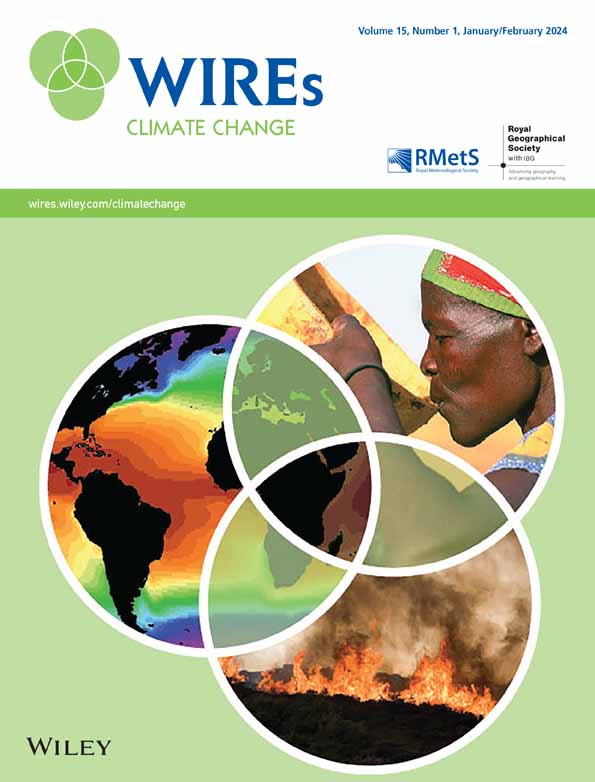珊瑚骨架的环境记录:十年的新见解和创新
IF 10.3
1区 环境科学与生态学
Q1 ENVIRONMENTAL STUDIES
引用次数: 24
摘要
在过去的几十年里,已经开发了数百个珊瑚古气候记录,极大地扩展了仪器记录,并提高了我们对热带气候变化和其他数据贫乏地区变化的理解。珊瑚“代理”记录测量钙化时骨骼地球化学或生长的变化,作为海洋条件的函数。在过去的十年里(自2010年以来),新的综合研究已经确定了古记录中独特的变暖和变异的连贯模式(尽管还不是前所未有的)。反过来,海洋变暖和酸化对珊瑚生长产生了不利影响,珊瑚的伸展减少,应力带增加。方法学的进步限制了不确定性,并提高了我们对珊瑚骨架中气候信息存档过程的理解。已经开发了描述这些过程的模型,以促进代理模型的比较,确定不确定性的来源,并提供一个基准,在高度可变的气候系统中可以检测到强迫变化。最后,一些创新的新指标扩展了可能从珊瑚中获得的气候和环境信息,包括:海水pH值、霰石饱和度、人为氮、径流和信风。应优先考虑进一步扩展已建立的和新的代理,以及海水监测和密度测量,以筛选和校准这些记录。由于这一关键的气候档案越来越受到变暖和海洋酸化的威胁,社区必须密切合作,以生态和文化敏感的方式收集这些宝贵的气候数据,以免为时已晚。本文章由计算机程序翻译,如有差异,请以英文原文为准。
Environmental records from coral skeletons: A decade of novel insights and innovation
Hundreds of coral paleoclimate records have been developed over the past several decades, significantly extending the instrumental record and improving our understanding of tropical climate variability and change in otherwise data‐poor regions. Coral “proxy” records measure the change in skeletal geochemistry or growth as a function of ocean conditions at the time of calcification. Over the past decade (since 2010), new syntheses have identified coherent patterns of warming and variability that are unique within the paleo record (albeit not yet unprecedented). In turn, ocean warming and acidification have had a detrimental impact on coral growth, with reduced extension and increased stress banding. Methodological advances have constrained uncertainties and improved our understanding of the processes by which climate information is archived in coral skeletons. Models that describe these processes have been developed to facilitate proxy‐model comparisons, identify sources of uncertainties, and provide a benchmark upon which forced changes may be detected within a highly variable climate system. Finally, several innovative new proxies have expanded the climate and environmental information that may be obtained from corals, including: seawater pH, aragonite saturation, anthropogenic nitrogen, runoff, and trade winds. Further extending established and novel proxies should remain a priority, along with seawater monitoring and density measurements with which to screen and calibrate these records. As this critical climate archive is increasingly threatened by warming and ocean acidification, the community must work closely together to collect this invaluable climate data in an ecologically and culturally sensitive manner, before it is too late.
求助全文
通过发布文献求助,成功后即可免费获取论文全文。
去求助
来源期刊

Wiley Interdisciplinary Reviews: Climate Change
METEOROLOGY & ATMOSPHERIC SCIENCES-
CiteScore
20.00
自引率
2.20%
发文量
58
审稿时长
>12 weeks
期刊介绍:
WIREs Climate Change serves as a distinctive platform for delving into current and emerging knowledge across various disciplines contributing to the understanding of climate change. This includes environmental history, humanities, physical and life sciences, social sciences, engineering, and economics. Developed in association with the Royal Meteorological Society and the Royal Geographical Society (with IBG) in the UK, this publication acts as an encyclopedic reference for climate change scholarship and research, offering a forum to explore diverse perspectives on how climate change is comprehended, analyzed, and contested globally.
 求助内容:
求助内容: 应助结果提醒方式:
应助结果提醒方式:


